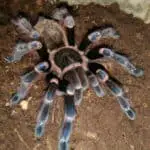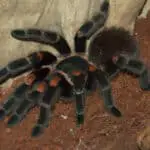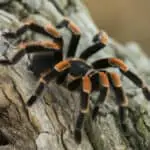As a new tarantula owner, you would want a pet that is easy to look after, gentle, affordable, and easy to find. However, the hundreds of species in the wild make it an uphill task to select the right fit, with some as large as 12 inches and others as small as 1 inch. Veteran owners can always find a Tarantula to look after, but it is quite tasking for a newbie. That’s why we are here to narrow it all down to the best species that will work perfectly for you.
1. Chilean Rose

This spider is one of the top picks for any beginner. It is originally from Chile, lives in Bolivia and Argentina, and is easy to spot due to its brown body and bright pink fur covering. Beginners are usually worried about aggressive spiders, but this option is surprisingly calm. They will only be violent when angry or when you don’t handle them properly. It is known to quickly adapt to environmental changes and survive harsh conditions, making them easy to care for since they only need basic care.
A mature pet can reach up to 5 inches; hence, great for lovers of medium-sized spiders. Another impressive characteristic is its long lifespan. Your female pet can reach and surpass two decades with good care, while the males can live for up to seven years. You will notice that they grow slowly, which makes them great value for your money.
It is advisable for its comfort and easy movement to select a large tank that is more than thrice as wide as its legs span and fill it with a thick substrate, perhaps of two inches. They also need a hideout when they get frightened and a heat source for the cold nights and chilly seasons.
2. Chilean flame

Compared to the Chilean Rose, this tarantula is smaller and lightweight. It measures less than 4 inches when fully grown; hence, suitable for beginners who are uncertain about giant spiders. The size is not overwhelming, making it easier for you to care for it. You will also find it adorable and gentle. They are friendly, curious and will often try to get your attention and initiate physical contact. If you want a social buddy to share with your friends and family, this species is a good place to start.
It will help you gain more experience as you slowly ease into being a spider parent. The Chile flame is a simple creature that doesn’t need specialized care. Among the few items you need include a thick substrate and a water bowl for their water needs. They thrive at a temperature ranging from 70- 80 degrees all year round; therefore, it is crucial to provide a heat source if it gets too cold. They may also require a cool place to retreat when the heat is excess or when they need some privacy.
One downside to these creatures is that they can lose their appetite and reject food when the cold season approaches. It is an innate characteristic that helps them survive in the wild, but it may worry you as a new owner. Secondly, the Chilean authorities are strict with their measures to curb the over-exportation of the species. Hence, it may be quite tasking to find it in the market. However, you can always contact reputable local breeders for one.
3. Honduran Curly Hair
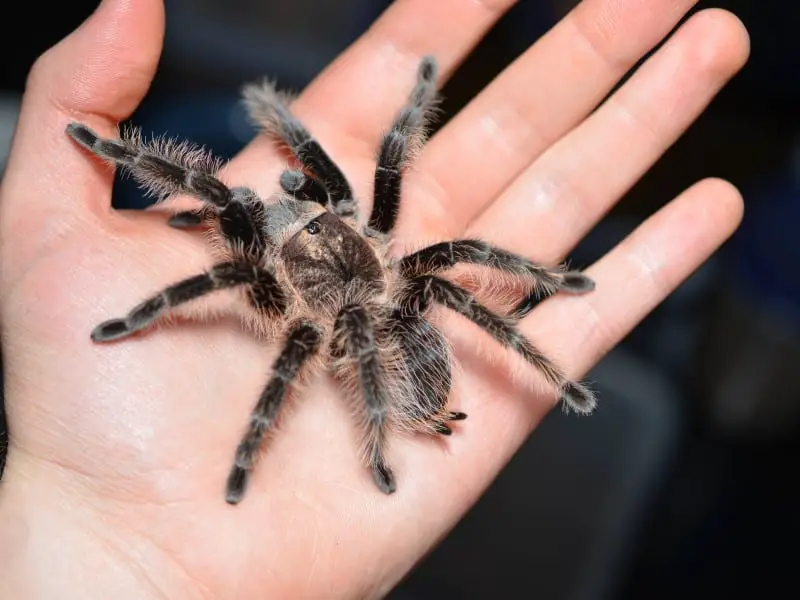
The woolly tarantula curly hair is another beginner-friendly tarantula species. Able to grow up to 5 inches and weigh one ounce, it is one of the dwarf spiders in the spider family. It is a popular tarantula in first-timer households thanks to its hardiness and gentle nature. The colorful and beautiful fur all over it makes it a wonderful sight to behold. The golden hairs easily capture attention against its dark-colored and round body. A 5-10 capacity tank can fit it just fine since it isn’t massive like its counterparts.
Females live for approximately a decade while males can reach four years. If you ask around for a great pet for a starter, curly hair will be one of the top picks. Apart from the calmness and general friendliness, it is one of the low maintenance spiders. It has a moderate growth rate, and there are very few cases of them showing hostility. They will only be aggressive if a predator is lurking or if the handler is rough. One advantage is that they are easy to find, and the hatchlings often come as freebies, making the purchase affordable.
Although they are quite hardy and able to adapt to a new home, they still need the best conditions. They require dry bedding in a large part of the tank and a small damp section when they need to cool down. Secondly, the temperature should be around 80 degrees. If you are going for hatchlings, it is best to provide a thick substrate for them to dig.
4. Arizona Blonde
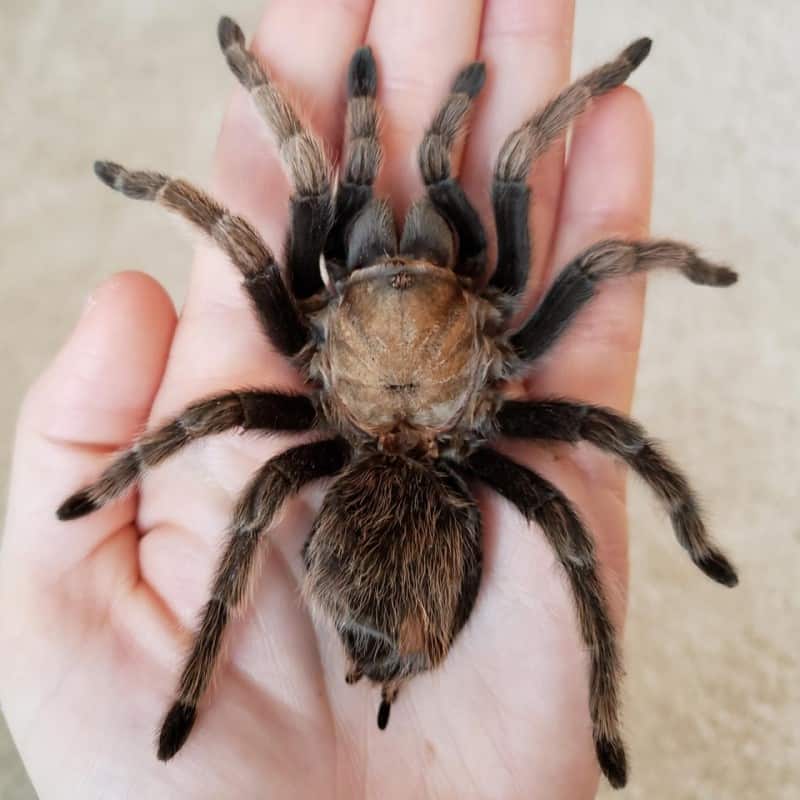
By its name, the spider is originally found in Arizona but also in Mexico and California. What tells it apart is the eccentric blonde complexion on some body parts and limbs, while the rest of it is a mixture of black on the femurs and brown on the abdomen. Their leg span can reach around five and a half inches, and their life span is an impressive 30 years for females and 10 for males. They are one of the most long-living tarantulas in the wild and will guarantee a great companion as long as you take good care of them.
Like most spiders we recommend, this one is a quiet spirit and mild-tempered. If you are looking for a creature that will not scare off all your friends, go for the gentle Arizona Blonde. The only concern is the occasional mood swings associated with most females. When in defense mode, they will raise their front limbs and flick their hairs, as they sense an intruder. They can fit in a five-gallon tank but ensure that it has a top cover.
This species is a great climber and can easily escape if you leave it in the open. Avoid using thin wire mesh since they can get stuck in tiny spaces. Also, consider a thick substrate of around three inches because they tend to climb and drop back into the cage, a fete that seems rather exciting for them.
5. Pink Zebra Beauty
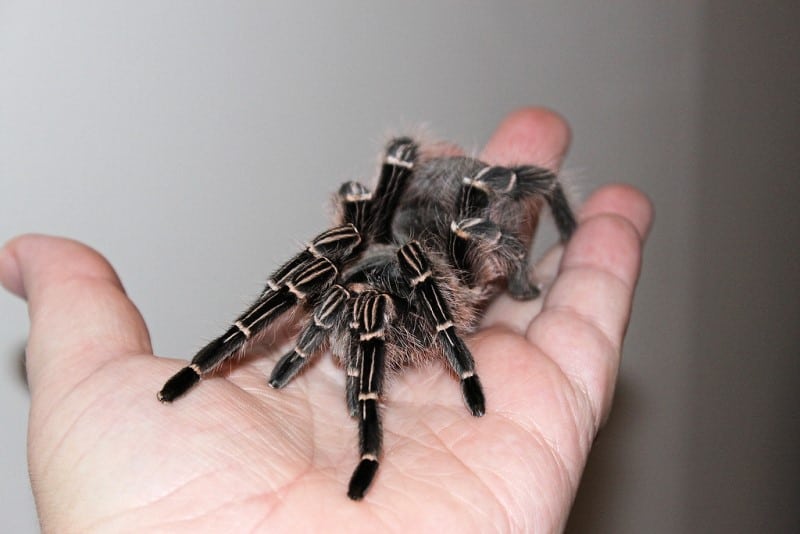
This species is famous for its beauty, thanks to its elegant features. It comes highly recommended not only for its appearance but its temperament too. Most owners will attest to its gentle nature and how well it interacts with humans, and you will love how much it allows handling. There are few instances, if any, of them being violent unless they have to. You will only find them trying to bite or kick hair when there is a real danger and have to go on defense mode.
Like most popular tarantulas, they are easy to look after since they only require basic care, as seen in this video below. They are known to manage average temperatures in the wild at around 60 degrees, and they can thrive at room temperature. Primarily, it hails from a region with high rainfall; therefore, they require a lot of water to stay hydrated. Regardless, you will find this species hardy and adaptable, able to blend well into its new home even if you acquired it as an adult.
The only concern with the pink zebra beauty is its slow growth. If you find hatchlings, you will need a lot of patience for them to reach sexual maturity. The main issue is if you intend to keep them for breeding reasons. Since very few beginners are keen on breeding their first spiders, it may not be a huge deal-breaker for you.
6. Pink Toe
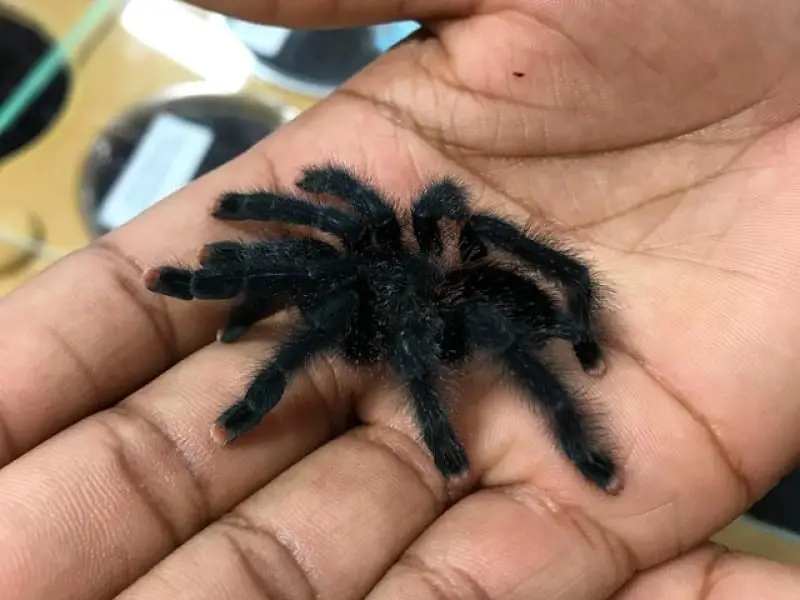
As the name suggests, you will immediately notice the pink color on this tarantula’s toes. With a South American original, the species is an arboreal spider, meaning that it lives on trees and not the ground like most members in our list. You can choose your preferred Pink Toe from the various species available. They all have a unique beauty and will stand out among other spiders. Another exceptional feature is that it is quite skittish, unlike most outgoing and comfortable ones under a human touch.
It takes a long time to establish trust, and you need to be cautious when you first handle it, as it will interpret any roughness as aggression. The tarantulas also have speed, and it’s best to keep a close eye on them to prevent them from escaping. Unlike most spiders, they are fast-growing, and you won’t have to wait long before having a fully grown tarantula.
You can always go for a sling because they are easy to find and will reach adulthood faster, which is great value for your money. It also helps those who are unfamiliar with the care for hatchlings. The only downside with this feature is that the fast-growing species usually have short life spans, meaning that your female tarantula may die even before reaching a decade.
7. Brazilian Black
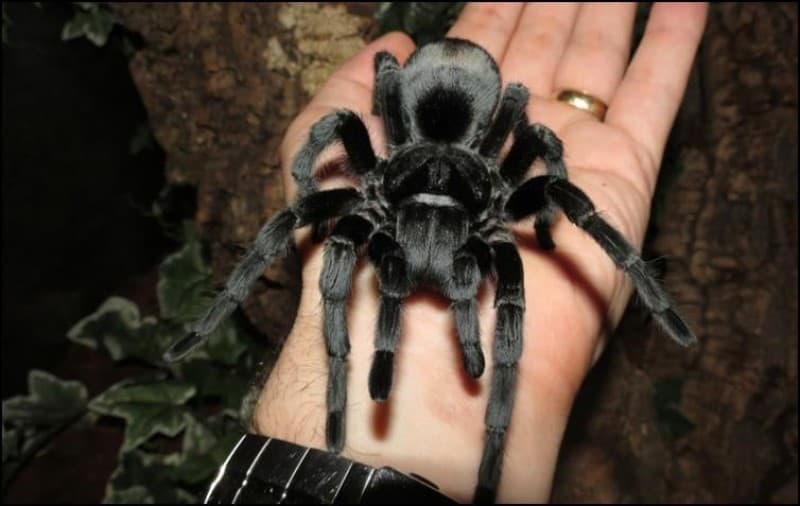
Some spider lovers refer to the Brazilian Black as a dark Chilean Rose. The two are in the same genus and are both gentle and low maintenance. They also move slowly; hence, you don’t need to worry that they would slip off your hold and disappear. Compared to the rose, these spiders are glossy black and chunkier, making them one of the most adorable tarantulas on our list. They are also more elegant and stunning, unlike their brown counterparts. Don’t let the size fool you. These creatures are meek, polite, and slow to anger. Many hail it for its ease of handling and reluctance to show aggression when there is no serious threat.
If you want a giant pet, the Brazilian Black will suffice because they can reach a whopping 8 inches at sexual maturity. Secondly, if you are keen on a lifelong companion, you will find them among the most long-living creatures, given their slow growth rate. A female can outlive most common household pets, and the males can near the decade mark.
Most new and patient owners find them a viable option and decide to buy them as hatchlings then watch them grow over the decades. Their slow growth has its advantages and disadvantages. Although it enables them to live long, the slow growth is why the spider is highly priced. It also requires you to be patient because they take long before they reach adulthood.
8. Mexican Red Knee
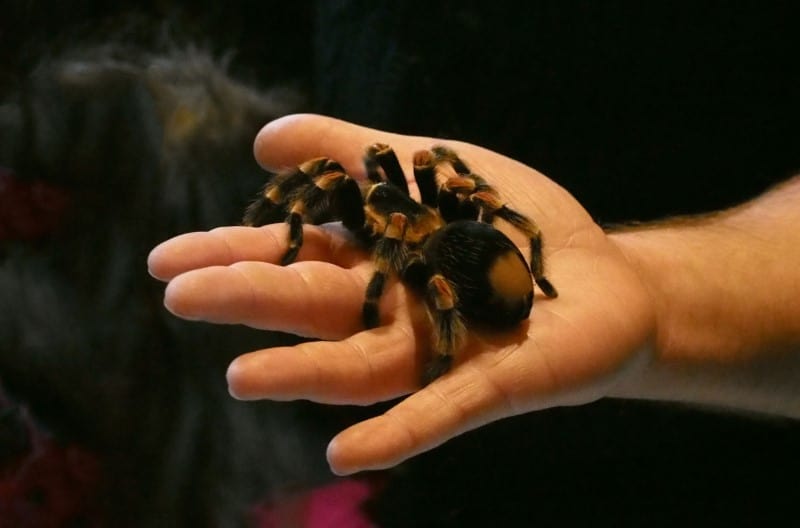
This tarantula species primarily lives in the dry parts of Mexico. Various people, including newbies, refer to it as an original tarantula. From its name, it is easy to spot given its unique bright coloration on its knee joints. The abdomen is black, while parts of the legs have reddish-orange stripes. You will be amazed by its stunning beauty as the bright colors carefully blend with the dark background complexion. A plus with these spiders is that since they live long, you will keep admiring and showing them off for a long time because females can live for over two decades.
They can grow to 6 inches in leg span and are one of the most long-living spiders. A female can exist for up to three decades while the male counterpart will only last one. One challenge you will have to deal with is their great running skills, as they tend to sprint off whenever they get the chance. They love spending their time burrowing while in the wild. Therefore, it would help set up a thick substrate to dig to their heart’s content.
It is currently one of the endangered spider species in the wild due to excessive capturing, making it tasking to find. Therefore, given that they have a slow growth rate and are mostly captive-bred, you will have to dig deeper into your pocket to purchase one.
9. Chaco Golden Knee

Another giant species is the Chaco Golden Knee that can reach 8 inches in full length. Most spiders of the Gramostola species are usually slow in growth but have the longest life spans. It takes years to reach maturity, and you may have to wait a little longer if you wish for hatchlings and generations. Their demeanor is calm, and you will love having it as a first tarantula. It is also family-friendly since there are very few reported hostility cases. They allow you to handle them, making it easy to let your kids and friends touch them.
Secondly, if you are looking for a species that you can display and show off, this spider is the right one for you. An added advantage is that it is one of the most affordable spider options in pet stores, with slings going for only 10$. They are also readily available, making it easy for a first-timer to purchase. You will find the young ones very playful as they love to dig their substrate. You can help them by making their bedding soft and thick. Consider a four-inch-thick substrate that is moist on one end to provide a cool area on a hot day.
The true nature of a spider varies, as not all tarantulas of the species are friendly. Experts always advise that you be cautious when handling the giant tarantulas because even the docile species like the Chaco Golden Knee can turn aggressive if you handle them incorrectly. Their bites are excruciating and can be severe.
10. Costa Rican Zebra
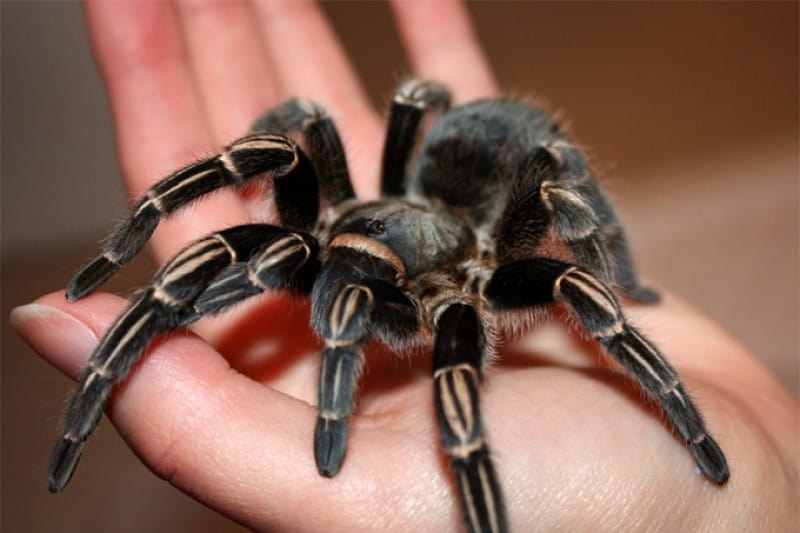
Like most spiders, the Costa Rican Zebra derives its name from its appearance and origin. It is from Costa Rica and parts of Central America, and you can always spot it by the white stripes on its limbs. Being against a black background, they appear like the zebra’s stripes. They are also quiet like most tarantulas on our list but skittish and easy to scare, especially when they contact unfamiliar humans. They will take a while to get comfortable in your presence, but they make one of the friendliest pets when they do.
The Costa Rican spiders are fast-running spiders that will give you a difficult time retrieving after escaping. It is only with frequent handling that they can get fond of your presence. These species are adorable and will be perfect for an owner who wants to start with a miniature spider because they reach around four and a half inches at full length. They need a conducive environment for them to thrive; being avid diggers, it is wise to make the substrate as thick as possible. They also need a place to hide when they need to.
11. Green Bottle Blue

This tarantula originates from the dry regions of Venezuela, and the desert life has made it hardy and able to survive in harsh environments. Many beginners love it due to its attractive look. It is one of the world’s most beautiful tarantulas boasting different tinges. It has a bright orange on the abdomen, bright blue on the long appendages, and its carapace has a blue-green layered hue, as the below clip describes. Besides the amazing cocktail of colors, the GBB has an incredible character and is one of the friendliest pet tarantulas.
Males have a shorter lifespan below ten years, while females can live for over ten years. Adult Green Bottle Blue Tarantulas can grow to more than ten centimeters at maturity. They are pretty large; therefore, you need to make a large terrarium for them to move freely. These great features make it a favorite among beginners and veterans who need to experiment with a different spider species.
These tarantulas are easy and cost-friendly to maintain. Other than the initial cost, you will only chip in to provide for its daily needs, and, in the long run, you will realize that it is a great value for money. For the terrarium, you will provide a dry substrate that doesn’t need to be sprayed every time, only a few times a week. A humid enclosure helps your spider web, which makes the tank look great. You can even go further to put up anchors to help hold the spider’s silk sturdy. This fascinating Tarantula species is available from most authorized spider breeders.
12. Brazilian Salmon Pink
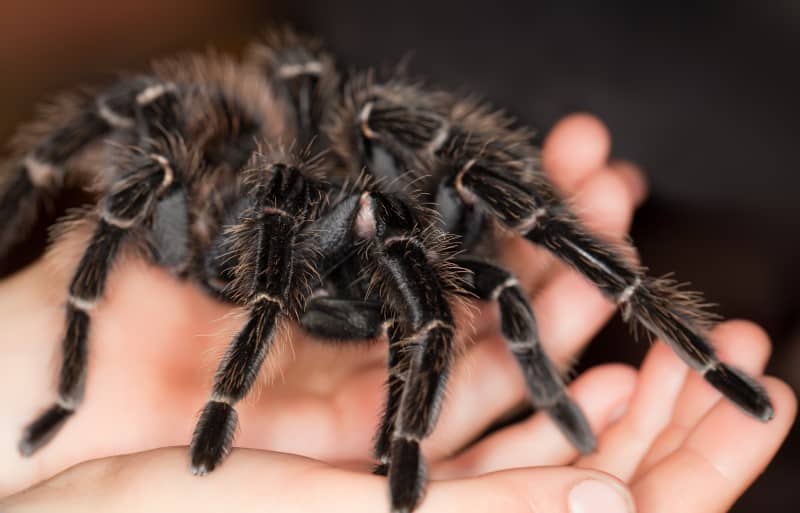
The Salmon Pink is a bird-eating spider that can grow to massive leg span lengths of about thirty centimeters when mature. Its gigantic nature makes it fall among one of the largest tarantulas worldwide. It is native to Southern Brazil and obtains its name from its color. The spiders, especially the juveniles, have a pinkish tinge, but adults lose the coloration and turn dark brown or black with a few pink patches on particular body parts. Most pet parents love to display their big tarantulas, and, if that is your intention, the Salmon Pink will not disappoint.
The tarantula occasionally indulges in birds as prey, but their diet mainly comprises small insects and some tiny vertebrates like frogs, mice, and lizards to spice up their menu. Unlike the green bottle, Salmon Pink tarantulas don’t make a lot of webs but can spin some to aid in setting traps to use during hunting.
While in captivity, it is necessary to provide food at intervals for elderly tarantulas. In contrast, the slings require a lot of food for growth and molting. Many owners feed them as much as they can to help them grow faster. Notably, it would be best if you were keen to avoid leaving leftovers that may attract harmful infections to the spider.
If you are a beginner eyeing a breeding species, it is easier to start with the Brazilian Salmon. Whenever you find it challenging, there are vets and specialized breeders around to help you. Hatchlings can live in a small enclosure as they grow, and once they outgrow it, you can find a spacious tank to fit them in. Since they are docile even with each other, they can live long, especially under great care. The female bird-eater can live for up to fifteen years, but males have a lower life expectancy.
13. Brazilian White Knee
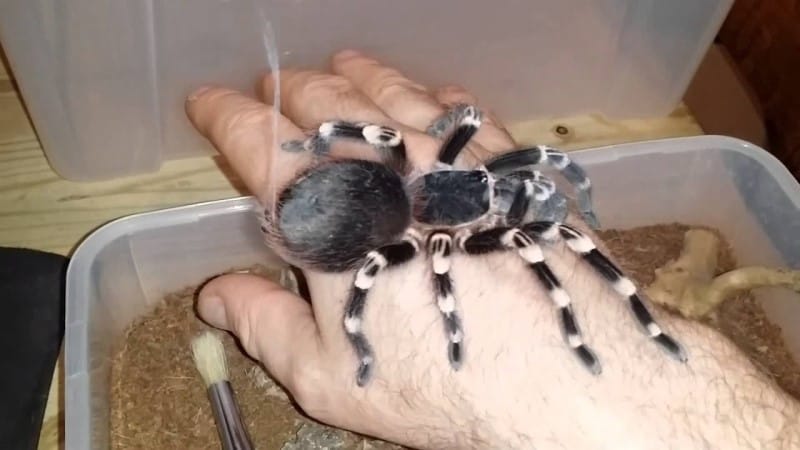
Popularly known as the Giant White Knee, it is common in Brazil’s tropical and warm rainforests. The spiders can manage heat levels of below thirty degrees Celsius, above which they will start hiding on trees and rocks to regulate their body temperatures. They are pretty calm animals but can be aggressive when you disturb them. Therefore, it is advisable to avoid bugging them to avoid them becoming violent. They possess powerful venoms that can be fatal to the victim; hence, it is wise to monitor them to know when to leave them alone.
The Brazilian White Knee tarantulas grow very fast when well fed and in a conducive environment. It can max out to a whopping six inches in diameter in just one year, which will alert you to construct a bigger enclosure. In captivity, you need to feed it various insects such as locusts, roaches, and crickets. You can do it once a week, but if you need them to fatten up a bit, you can occasionally provide small mice.
Male and female White Knee Tarantulas have different life spans, with the males living below five years while the females can go for almost two decades. Therefore, if you need a long-lasting companion, we highly suggest going for the female tarantulas, regardless of the species. Mating the two is a smooth exercise, such that if you need to raise a colony, this spider is your best shot.
14. Mexican Bloodleg
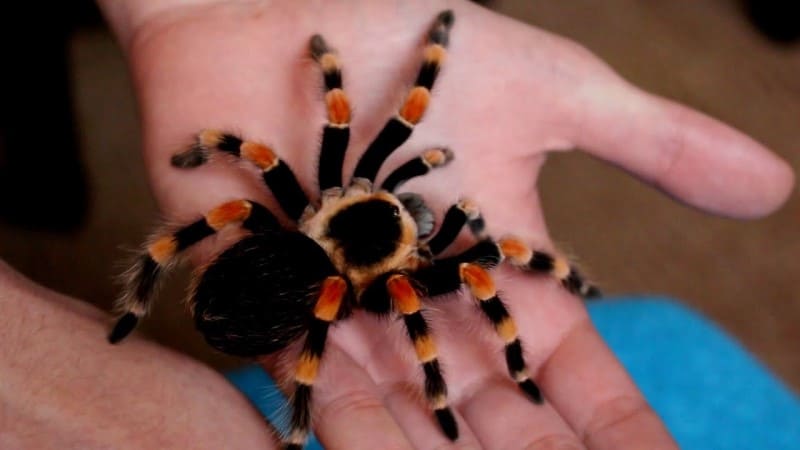
Also called the Mexican Beauty, this tarantula is common in the desert regions of South Western Mexico. It is a new world tarantula whose venom is believed to be less potent than that of deadly spiders, and its bite does not cause severe medical issues. However, urticating hair can cause ailments when it comes into contact with your skin, and the symptoms include itching, redness, and hives. The bloodleg tarantula is docile, making it convenient for newbies; however, juveniles may be a bit aggressive and only quiet down as they get older.
The tarantula isn’t as huge as the Green Bottle since it can grow to about five inches when fully matured. They are also one of the most famous spiders for their long lives as the females can live to their thirtieth birthday while the males reach thirteen years, which is also rather impressive. The Mexican Bloodleg is easy to breed since the females lay numerous eggs, which they keep in silk bags. If you are planning to venture into breeding, consider this species a great specimen.
The females also guard their eggs against predators until they hatch. This tarantula would rather scare you away with its hair than bite you, although its venom is mild and less severe than a bee sting. Mexican Bloodlegs are readily available at authorized exotic pet spider dealers, where you can grab one for your own or gift a loved one.
15. Martinique Red Spider
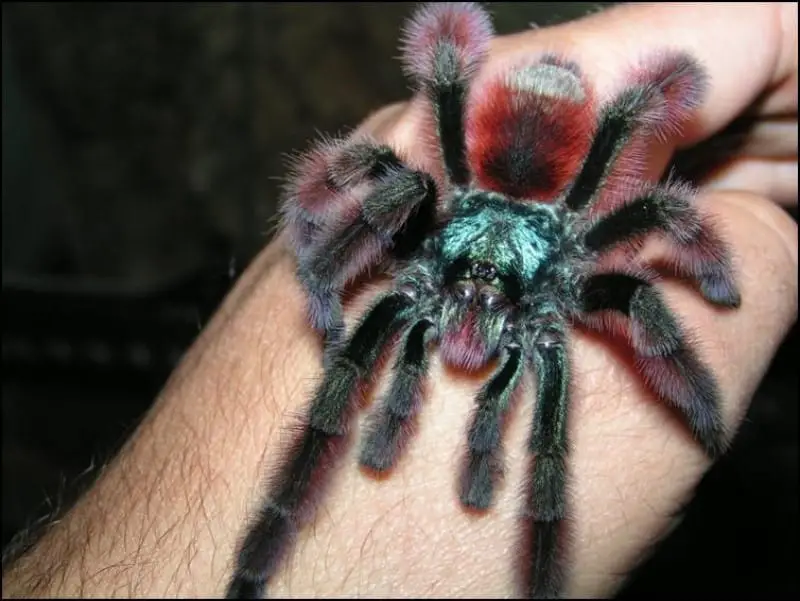
The spider is native to Guadeloupe and Martinique in the Caribbean. It is otherwise known as the Martinique Pink Toe, Antilles Pink-toed Spider, or the Martinique Red Tree Spider. As its name hints, it has pink toes. However, it isn’t as colorful during its early stages, only as it becomes an adult. Its legs are covered with different hues of hairs such as red, purple, and blue, making it one of the most appealing multicolored spiders. Moreover, the spider boasts of a metallic green tinge on the carapace, making it very easy to spot while in the wild.
The tarantula is primarily among the medium-sized Tarantulas with body and limb lengths of about 6 inches, where the females are bigger than the male counterparts. The species usually live on trees while in the wild, unlike most terrestrial tarantulas discussed. They build their webs on tree backs to make their habitats and set traps for their prey. The tarantula’s main diet is insects; however, it occasionally treats itself to fleshy mice, frogs and lizards.
The Pink-toed Spider is easygoing and loved by many hobbyists; thus, a suitable choice for a first-timekeeper. A 10 or 15-gallon tank will fit it perfectly, and since they are arboreals, you can add tree-like accessories to imitate their natural habitat where they can construct their webs. The spider is not endangered, and you are likely to find one at the nearest pet stores or breeders. Finally, expect the females to live for over ten years and the males for only two depending on the factors t hand.
16. Chilean Gold Burst
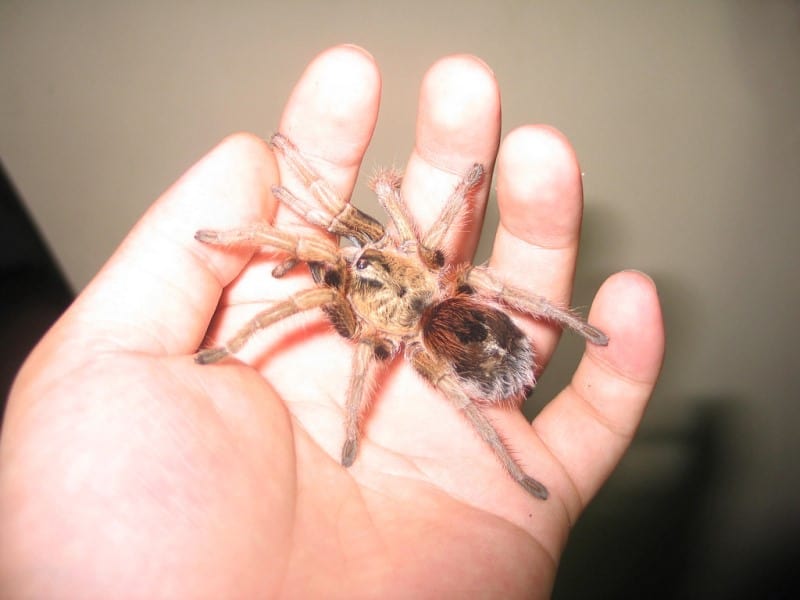
This spider is native to Chile and is one of the medium-sized spiders growing to nearly 4 inches. It is a docile and calm species that every new hobbyist would love to keep. First, the tarantula’s beauty is breathtaking. If you see it under bright light, you will notice the shimmering gold carapace that explains its name. It also has a silver hue on its limbs due to the white hair covering and a pale red color from the abdominal hair.
If you need a calm and collected T, the Chilean Gold Burst is your ideal choice. The spider can sit in its enclosure for hours without making any significant movements. Otherwise, if you are going for a more outgoing and free-spirited tarantula, you can select active species like the Martinique Red Spider. This pet’s most conducive environment is a sizeable tank of approximately ten by ten by eighteen inches. Secondly, they require 65-70 degrees temperatures and low humidity.
The Tarantulas are low maintenance since they are not fussy eaters and usually enjoy various insects and worms. They are quite affordable, and you are likely to acquire them from a trusted breeder. The pets can live for many years while in captivity provided that there are no predators and have the best care from the owner. Females can live for over a decade, while males have a shorter life expectancy, as seen with all the spider species.
To Wrap It Up
We wouldn’t want you to fail at your first attempt at owning a tarantula, which is why we have presented to you our top choices that suit any beginner. All the spiders are gentle, easy to look after, readily available, and affordable, all great qualities for a new keeper. Consider them all, and we guarantee that you will find your best match. If you found this article helpful, feel free to share this piece with avid tarantula lovers to help them out.
Read more: Are Tarantulas Friendly

